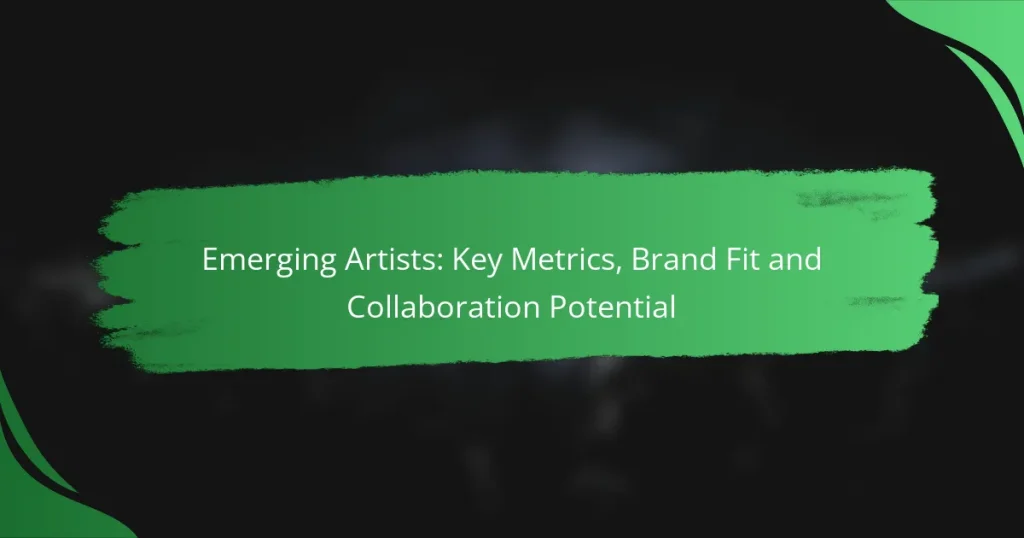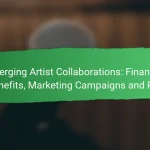In today’s competitive landscape, identifying the right emerging artists for brand collaborations is crucial. By analyzing key metrics such as social media engagement, audience demographics, and previous collaboration success, brands can ensure a strong alignment with their values and target audience. This strategic evaluation not only enhances the authenticity of partnerships but also maximizes the potential for impactful engagement.

How to evaluate emerging artists for brand collaboration?
Evaluating emerging artists for brand collaboration involves assessing their social media engagement, audience demographics, previous collaboration success, and the quality of their content. These factors help determine if an artist aligns with your brand values and can effectively reach your target audience.
Social media engagement metrics
Social media engagement metrics are crucial for understanding how well an artist connects with their audience. Key metrics include likes, shares, comments, and follower growth rates. Look for artists with engagement rates above industry averages, typically around 1-3% for posts, as this indicates a more active and interested audience.
Consider the platforms where the artist is most active. For instance, Instagram and TikTok are popular for visual artists, while Twitter may be better for musicians. Analyze the type of content that generates the most interaction to gauge what resonates with their followers.
Audience demographics analysis
Understanding the audience demographics of an emerging artist helps ensure alignment with your brand’s target market. Analyze factors such as age, gender, location, and interests. Tools like social media analytics can provide insights into the artist’s follower base, helping you assess if it matches your desired consumer profile.
For example, if your brand targets millennials, an artist with a predominantly young adult audience may be a better fit. Additionally, consider cultural and regional factors that could influence the artist’s appeal in specific markets.
Previous collaboration success
Reviewing an artist’s previous collaborations can provide insight into their reliability and effectiveness in partnership. Look for case studies or testimonials from brands they have worked with, focusing on campaign results and audience reception. Successful collaborations often reflect the artist’s ability to integrate brand messaging seamlessly into their content.
Consider the types of brands they have partnered with and the outcomes of those collaborations. A history of working with similar brands or within your industry can indicate a better understanding of brand expectations and audience engagement.
Content quality and originality
The quality and originality of an artist’s content are vital indicators of their potential for collaboration. Assess their portfolio for creativity, consistency, and production value. High-quality visuals or music can enhance your brand’s image and attract attention.
Look for unique storytelling or innovative approaches that set the artist apart from others. Original content is more likely to resonate with audiences, making it essential for successful brand partnerships. Avoid artists who rely heavily on trends without adding their unique twist, as this may lead to a lack of authenticity.
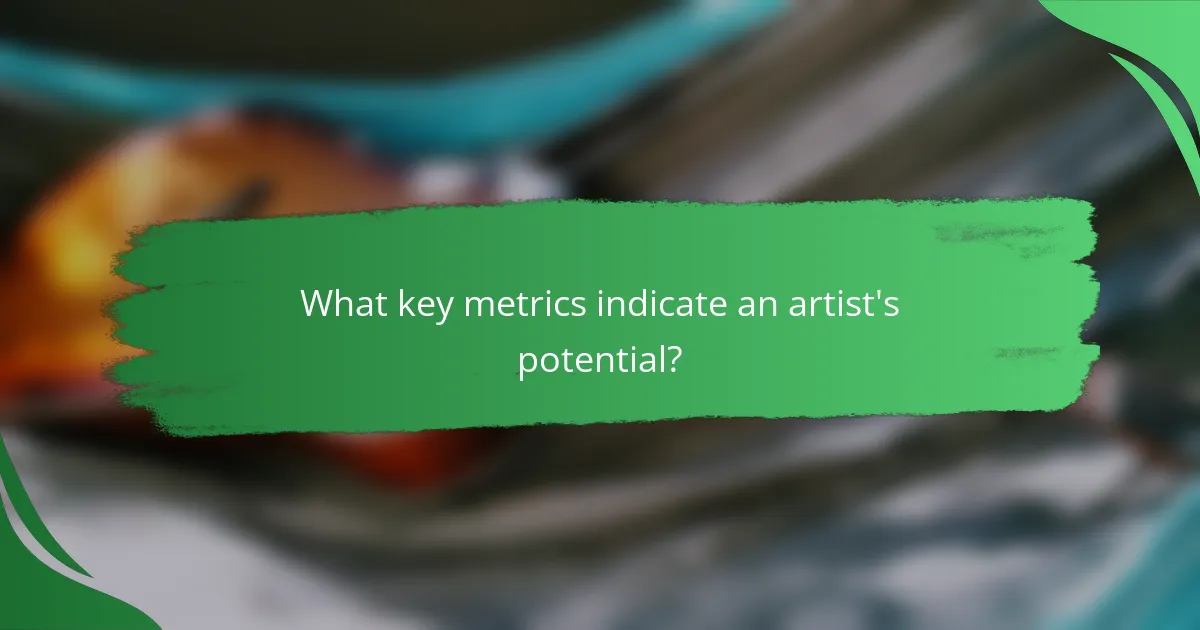
What key metrics indicate an artist’s potential?
Key metrics that indicate an artist’s potential include their follower growth rate, average engagement rate, and streaming statistics on platforms like Spotify. These metrics provide insights into an artist’s popularity, audience interaction, and overall marketability.
Follower growth rate
The follower growth rate measures how quickly an artist is gaining new followers over a specific period. A consistent increase in followers, ideally in the double digits percentage-wise month-over-month, suggests rising interest and potential for future success.
To assess this metric, compare the number of followers at the beginning and end of a defined timeframe, such as three months. Rapid growth can indicate effective marketing strategies or viral content, while stagnation may signal the need for new promotional efforts.
Average engagement rate
The average engagement rate reflects how actively an artist’s audience interacts with their content, typically calculated as the sum of likes, comments, and shares divided by total followers. A healthy engagement rate usually falls between 1% to 5%, depending on the platform and genre.
High engagement rates suggest that the artist’s content resonates well with their audience, which is crucial for attracting brand partnerships. Monitoring this metric can help identify what types of content generate the most interaction, guiding future posts.
Streaming statistics on platforms like Spotify
Streaming statistics, particularly on platforms like Spotify, provide valuable insights into an artist’s reach and listener demographics. Key figures to consider include monthly listeners, total streams, and playlist placements, which can indicate an artist’s popularity and growth trajectory.
For example, an artist with tens of thousands of monthly listeners and a steady increase in streams may be well-positioned for collaboration opportunities. Regularly reviewing these statistics helps artists and brands understand market trends and audience preferences, enabling informed decisions on partnerships and promotional strategies.
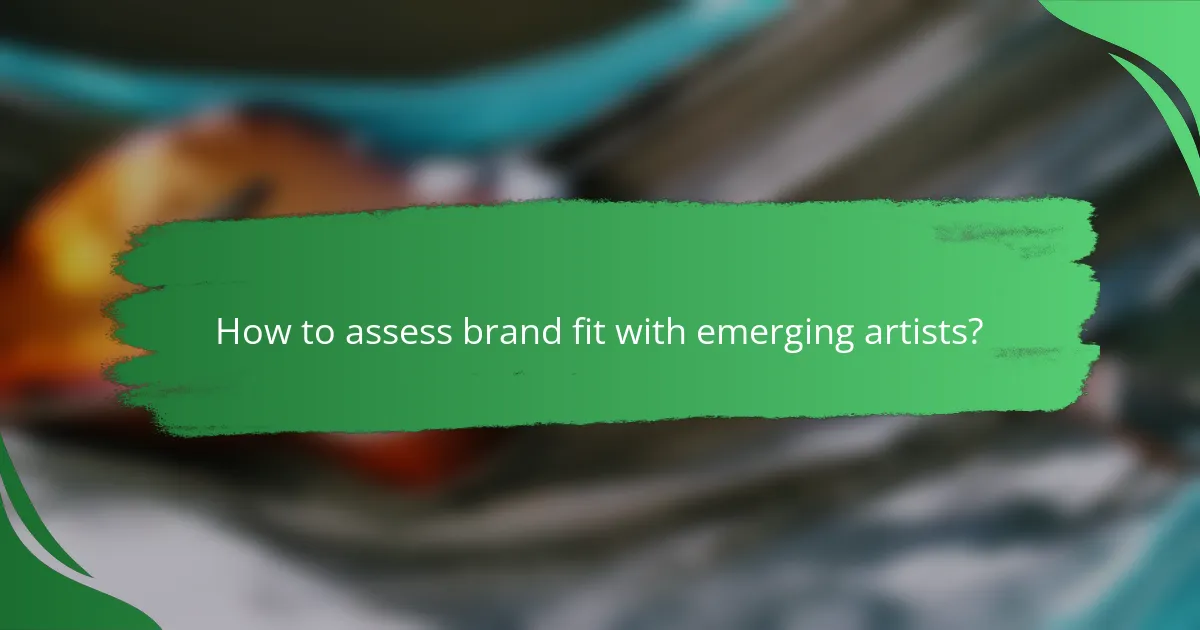
How to assess brand fit with emerging artists?
Assessing brand fit with emerging artists involves evaluating how well their values, audience, and content style align with your brand’s identity. This process ensures that collaborations resonate authentically with both the artist’s and the brand’s followers.
Brand values alignment
Brand values alignment refers to the degree to which an emerging artist’s principles and beliefs match those of your brand. This can include social responsibility, sustainability, or artistic integrity. For instance, if your brand emphasizes eco-friendliness, collaborating with an artist known for environmental advocacy can enhance credibility.
To assess alignment, review the artist’s past projects, statements, and social media presence. Look for consistent messaging that reflects values similar to yours. A mismatch can lead to backlash or confusion among consumers.
Target audience compatibility
Target audience compatibility is crucial for successful collaborations. It involves understanding whether the artist’s fan base overlaps with your customer demographic. For example, if your brand targets millennials, partnering with an artist who has a strong following in that age group can amplify your reach.
Utilize social media analytics tools to gauge audience demographics and engagement levels. Consider conducting surveys or focus groups to gather insights on potential audience reactions to the collaboration. This data can guide your decision-making process.
Content style and messaging
Content style and messaging encompass the tone, aesthetics, and themes an artist employs in their work. Ensuring that these elements align with your brand’s communication strategy is vital for authenticity. For instance, a playful and vibrant artist may not fit well with a luxury brand’s sophisticated image.
Analyze the artist’s previous content to identify their unique style and messaging. Create a checklist of key attributes that your brand embodies and compare them against the artist’s work. This will help you determine if the collaboration will resonate positively with both audiences.
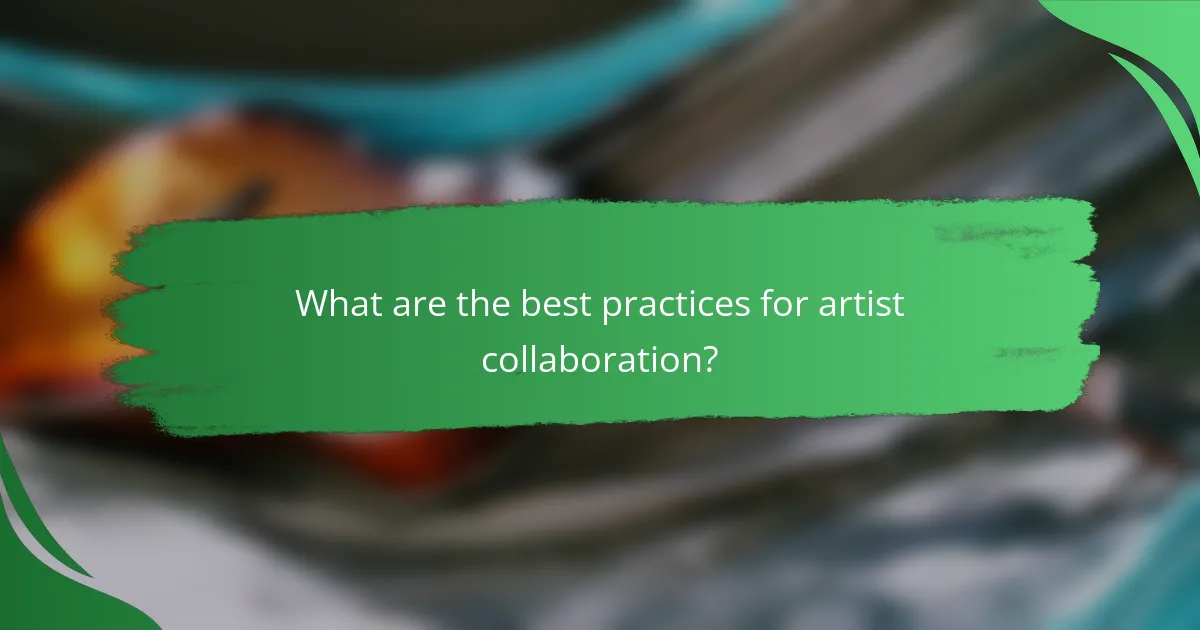
What are the best practices for artist collaboration?
Effective artist collaboration hinges on clear communication, defined roles, and measurable outcomes. These practices ensure that all parties are aligned and working towards a common goal, maximizing the potential for successful partnerships.
Clear communication of goals
Establishing clear communication of goals is essential for any artist collaboration. All collaborators should openly discuss their objectives and expectations from the outset to avoid misunderstandings. This can include artistic vision, target audience, and desired outcomes.
Regular check-ins can help maintain alignment as the project progresses. Utilize tools like shared documents or project management software to keep everyone informed and engaged.
Defining roles and responsibilities
Defining roles and responsibilities is crucial to ensure each artist knows their contributions. Clearly outline who is responsible for specific tasks, such as songwriting, production, or marketing. This clarity helps prevent overlap and confusion.
Consider creating a simple chart that lists each collaborator alongside their designated tasks. This visual aid can serve as a quick reference throughout the collaboration process.
Setting measurable outcomes
Setting measurable outcomes allows collaborators to track progress and assess success. Identify key performance indicators (KPIs) that reflect the project’s goals, such as streaming numbers, social media engagement, or audience feedback.
Establishing benchmarks at the start can provide a roadmap for the collaboration. Regularly review these metrics to adjust strategies as needed, ensuring that all artists remain focused on achieving their shared objectives.
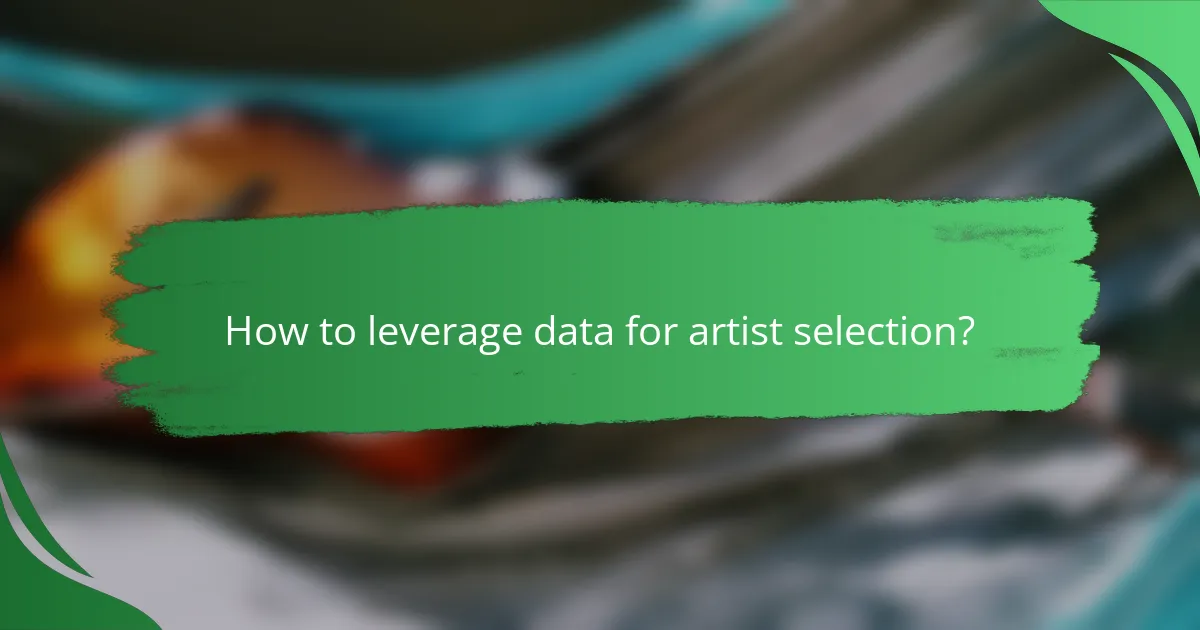
How to leverage data for artist selection?
Leveraging data for artist selection involves using various metrics and tools to assess an artist’s potential fit for your brand and collaboration opportunities. By analyzing performance data and audience engagement, you can make informed decisions that align with your marketing goals.
Using analytics tools like Hootsuite
Analytics tools such as Hootsuite provide valuable insights into an artist’s social media performance, audience demographics, and engagement rates. These metrics help identify artists whose followers align with your target market, ensuring a better brand fit.
When using Hootsuite, focus on key performance indicators like follower growth, post engagement, and audience sentiment. Regularly monitoring these metrics can reveal trends and shifts in audience preferences, allowing for timely adjustments in your collaboration strategy.
Conducting market research surveys
Market research surveys are an effective way to gather direct feedback from your target audience regarding their preferences for artists. By asking specific questions about music styles, favorite artists, and collaboration expectations, you can gain insights that data alone may not provide.
To conduct effective surveys, consider using platforms like SurveyMonkey or Google Forms. Aim for a sample size that reflects your audience demographics, and keep surveys concise to encourage participation. Analyzing the results will help you identify artists who resonate well with your audience, enhancing the potential for successful collaborations.
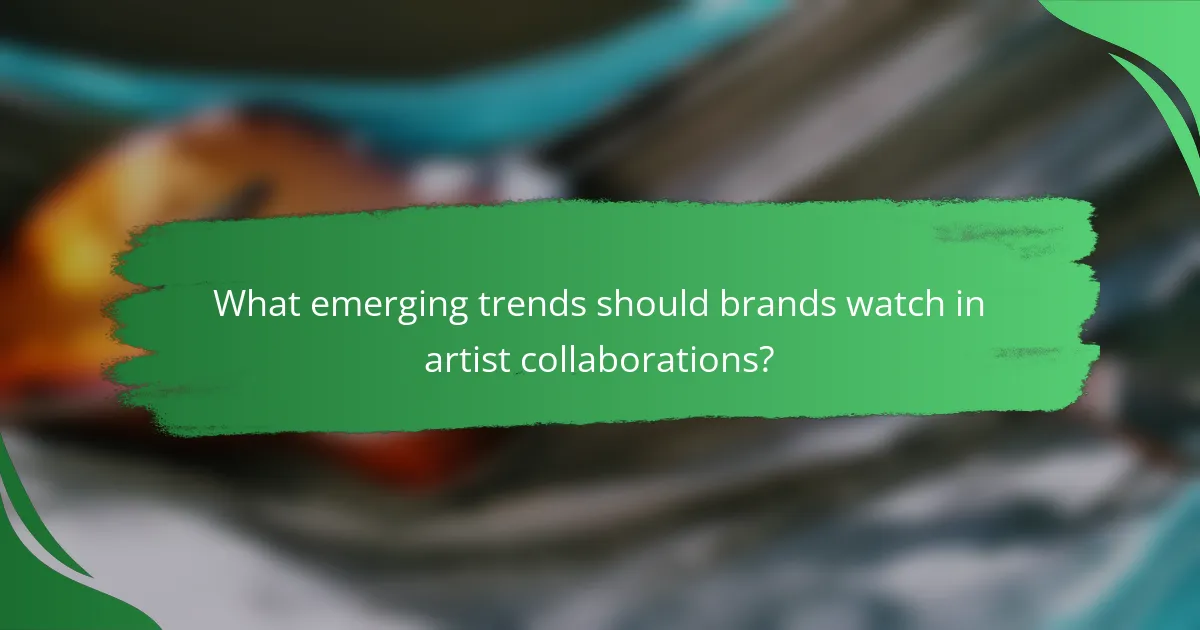
What emerging trends should brands watch in artist collaborations?
Brands should focus on authenticity, sustainability, and digital engagement when collaborating with emerging artists. These trends reflect consumer preferences for genuine connections, eco-friendly practices, and innovative digital experiences.
Authenticity in Collaborations
Authenticity is crucial for successful artist collaborations. Brands should seek artists whose values align with their own, ensuring a genuine partnership that resonates with audiences. For instance, a brand promoting wellness might collaborate with an artist known for their holistic lifestyle.
To assess authenticity, brands can evaluate an artist’s social media presence, previous collaborations, and community engagement. This helps in identifying artists who genuinely embody the brand’s ethos, leading to more impactful campaigns.
Sustainability Focus
Sustainability is becoming a key consideration in artist collaborations. Brands are increasingly partnering with artists who advocate for environmental causes or use sustainable materials in their work. This not only enhances brand image but also appeals to eco-conscious consumers.
For example, a fashion brand might collaborate with an artist who creates artwork from recycled materials, showcasing a commitment to sustainability. Brands should prioritize artists who actively promote green practices to strengthen their own sustainability narratives.
Digital Engagement Strategies
Digital engagement is transforming how brands collaborate with emerging artists. Utilizing platforms like social media, virtual reality, and NFTs can create immersive experiences that attract younger audiences. Brands should explore these digital avenues to enhance their reach and engagement.
For instance, hosting a virtual art exhibit featuring an emerging artist can generate buzz and foster community interaction. Brands should stay updated on digital trends and invest in technology that enhances collaboration and audience participation.
